Long-Term Trends, Interannual Variability and Seasonal Patterns of Mean Sea Level in the Canary Islands
Abstract
1. Introduction
- Long-term trends
- Interannual variability
- Seasonal variability
2. Materials and Methods
2.1. Data
- ○
- Monthly mean sea level records from the tide gauges at Las Palmas de Gran Canaria (LP) and Santa Cruz de Tenerife (SC), shown in Figure 1, covering the period from January 1993 to January 2023, were obtained from the Permanent Service for Mean Sea Level global repository (PSMSL, https://psmsl.org/data/, accesed on 28 April 2025) [31,32]. These two stations were selected due to the length and completeness of their time series, which ensures the robustness of sea level trend estimation. Data from PSMSL was preferred because it undergo a rigorous quality control process that enhances reliability, particularly important when merging time series recorded with different types of instruments, as often occurs when equipment is updated or replaced. Among the PSMSL stations in the Canary Islands, only Las Palmas and Santa Cruz provide long, continuous, RLR-referenced monthly records spanning the full altimetric era. Other stations are shorter and/or discontinuous, which limits their utility for robust long-term trend estimation. We therefore use these two gauges to quantify local relative sea-level (RSL) change at port settings, and we complement them with the CMEMS gridded Level 4 altimetry to assess the archipelago-scale variability and trends.
- ○
- Monthly sea surface height above the ellipsoid derived from satellite altimeter for the Canary Islands region was obtained from the Global Ocean Gridded L4 Sea Surface Heights and Derived Variables–Reprocessed dataset provided by the Copernicus Marine Environment Monitoring Service (CMEMS) [35]. This Level 4 dataset merges and cross-calibrates multiple along-track missions into a 0.25° × 0.25° grid (1993–2024). We extracted the nearest grid cell to each tide gauge and computed monthly means. Product accuracy and homogeneity are documented in the CMEMS Quality Information Document (QUID). Independent assessments indicate that Data Unification and Altimeter Combination System (DUACS) maps resolve wavelengths of ~100–300 km (mid-latitudes) with an effective temporal resolution close to monthly [36]. Thus, while the gridded fields are well suited to analyzing regional variability and trends, they cannot fully resolve very local coastal signals that a point tide gauge may record.
- ○
- Sea surface temperature (SST) for the study area was obtained from the Multi-Observation Global Ocean ARMOR3D L4 analysis and multi-year reprocessed product provided by the CMEMS. The dataset covers the period 1993–2023 and includes monthly fields of temperature, salinity, sea level, geostrophic currents, and mixed layer depth, all provided on a regular 1/8° grid.
- ○
- Monthly time series of GMSL variation from 1900 to 2018 were obtained from the reconstruction developed by Frederikse et al. (available at https://zenodo.org/records/6067895, accessed on 17 March 2025) [12]. This model combines observations of ocean mass (barystatic component) and thermal expansion (thermosteric component), along with tide gauge records from around the globe corrected for vertical land motion and gravitational effects. The resulting dataset is illustrated in Figure 2.
- ○
- Vertical land motion data derived from GNSS measurements were obtained from the PSMSL and the Système d’Observation du Niveau des Eaux Littorales (SONEL). These data are available at https://psmsl.org (accessed on 28 April 2025) and https://www.sonel.org (accessed on 22 April 2025). The results of two recent studies by Barbero et al. [38] and Pfeffer & Allemand [22] were also used.
- ○
- Sea level rise projections produced by NASA for the most recent Assessment Report of the Intergovernmental Panel on Climate Change [1]. These projections, based on historical reconstructions and coupled ocean–cryosphere model simulations, provide estimates of future sea level changes through the year 2150. They are accessible via an interactive tool at https://sealevel.nasa.gov/ipcc-ar6-sea-level-projection-tool (accessed on 22 April 2025) [39].
2.2. Methodology
- Trend estimation: Obtained by fitting a GLS model with AR(1) residuals to the monthly time series, as described above. To avoid biases due to incomplete seasonal cycles, years with missing months at the beginning or end of the series were excluded from the analysis.
- Interannual anomalies: Obtained by subtracting the long-term linear trend from the annual mean sea level values.
- Seasonal anomalies: Obtained by subtracting the annual mean sea level from the monthly mean sea level values.
3. Results
3.1. Long-Term Variability
3.2. Interannual Anomalies
3.3. Seasonal Anomalies
3.4. Future Projections
4. Discussion
4.1. Long-Term Trend
4.2. Vertical Land Motion
4.3. Interannual Variability
4.4. Seasonal Cycle
4.5. Future Projections
5. Conclusions
Author Contributions
Funding
Data Availability Statement
Conflicts of Interest
Abbreviations
| AMO | Atlantic Multidecadal Oscillation |
| AMOC | Atlantic Meridional Overturning Circulation |
| CI | Confidence Interval |
| CMEMS | Copernicus Marine Environment Monitoring Service |
| DUACS | Data Unification and Altimeter Combination System |
| EA | East Atlantic Pattern |
| EKE | Eddy Kinetic Energy |
| ENSO | El Niño–Southern Oscillation |
| GLS | Generalized Least Squares |
| GMSL | Global Mean Sea Level |
| GNSS | Global Navigation Satellite System |
| IPCC | Intergovernmental Panel on Climate Change |
| LMSL | Local Mean Sea Level |
| LP | Las Palmas de Gran Canaria (Tide Gauge Station) |
| NAO | North Atlantic Oscillation |
| PDO | Pacific Decadal Oscillation |
| PSMSL | Permanent Service for Mean Sea Level |
| SC | Santa Cruz de Tenerife (Tide Gauge Station) |
| SSP | Shared Socioeconomic Pathways (IPCC Emission Scenarios) |
| SST | Sea Surface Temperature |
References
- IPCC. Climate Change 2023: Synthesis Report. In Contribution of Working Groups I, II and III to the Sixth Assessment Report of the Intergovernmental Panel on Climate Change; Core Writing Team, Lee, H., Romero, J., Eds.; IPCC: Geneva, Switzerland, 2023; p. 184. [Google Scholar] [CrossRef]
- Neumann, B.; Vafeidis, A.T.; Zimmermann, J.; Nicholls, R.J. Future Coastal Population Growth and Exposure to Sea-Level Rise and Coastal Flooding: A Global Assessment. PLoS ONE 2015, 10, e0118571. [Google Scholar] [CrossRef] [PubMed]
- Kopp, R.E.; Hay, C.C.; Little, C.M.; Mitrovica, J.X. Geographic Variability of Sea-Level Change. Curr. Clim. Change Rep. 2015, 1, 192–204. [Google Scholar] [CrossRef]
- Nicholls, R.J. Planning for the Impacts of Sea Level Rise. Oceanography 2011, 24, 144–157. [Google Scholar] [CrossRef]
- Stammer, D.; Cazenave, A.; Ponte, R.M.; Tamisiea, M.E. Causes for Contemporary Regional Sea Level Changes. Annu. Rev. Mar. Sci. 2013, 5, 21–46. [Google Scholar] [CrossRef]
- Woodworth, P.L.; Melet, A.; Marcos, M.; Ray, R.D.; Wöppelmann, G.; Sasaki, Y.N.; Cirano, M.; Hibbert, A.; Huthnance, J.M.; Monserrat, S.; et al. Forcing Factors Affecting Sea Level Changes at the Coast. Surv. Geophys. 2019, 40, 1351–1397. [Google Scholar] [CrossRef]
- Oppenheimer, M.; Glavovic, B.C.; Hinkel, J.; van de Wal, R.; Magnan, A.K.; Abd-Elgawad, A.; Cai, R.; Cifuentes-Jara, M.; DeConto, R.M.; Ghosh, T.; et al. Sea Level Rise and Implications for Low-Lying Islands, Coasts and Communities. In IPCC Special Report on the Ocean and Cryosphere in a Changing Climate; Pörtner, H.O., Roberts, D.C., Masson-Delmotte, V., Zhai, P., Tignor, M., Poloczanska, E., Mintenbeck, K., Alegría, A., Nicolai, M., Okem, A., et al., Eds.; Cambridge University Press: Cambridge, UK, 2019; pp. 321–445. [Google Scholar] [CrossRef]
- Fraile-Jurado, P.; Sánchez-Rodríguez, E.; Fernández-Díaz, M.; Pita, M.F.; López-Torres, J.M. Estimación del Comportamiento Futuro del Nivel del Mar en las Islas Canarias a partir del Análisis de Registros Recientes. Geographicalia 2014, 66, 79–98. [Google Scholar] [CrossRef]
- Marrero-Betancort, N.; Marcello, J.; Rodríguez-Esparragón, D.; Hernández-León, S. Sea Level Change in the Canary Current System during the Satellite Era. J. Mar. Sci. Eng. 2022, 10, 936. [Google Scholar] [CrossRef]
- Pugh, D.; Woodworth, P.L. Sea-Level Science: Understanding Tides, Surges, Tsunamis and Mean Sea-Level Changes; Cambridge University Press: Cambridge, UK, 2014. [Google Scholar]
- Biguino, B.; Haigh, I.D.; Antunes, C.; Lamas, L.; Tel, E.; Dias, J.M.; Brito, A.C. Seasonal Patterns, Inter-Annual Variability, and Long-Term Trends of Mean Sea Level along the Western Iberian Coast and the North Atlantic Islands. J. Geophys. Res. Oceans 2024, 129, e2023JC020742. [Google Scholar] [CrossRef]
- Frederikse, T.; Landerer, F.W.; Caron, L.; Adhikari, S.; Parkes, D.; Humphrey, V.W.; Dangendorf, S.; Hogarth, P.; Zanna, L.; Cheng, L.; et al. The Causes of Sea Level Rise since 1900. Nature 2020, 584, 393–397. [Google Scholar] [CrossRef]
- Church, J.A.; White, N.J.; Konikow, L.F.; Domingues, C.M.; Cogley, J.G.; Rignot, E.; Gregory, J.M.; van den Broeke, M.R.; Monaghan, A.J.; Velicogna, I. Revisiting the Earth’s Sea-Level and Energy Budgets from 1961 to 2008. Geophys. Res. Lett. 2011, 38, L18601. [Google Scholar] [CrossRef]
- Dangendorf, S.; Hay, C.; Calafat, F.M.; Marcos, M.; Piecuch, C.G.; Berk, K.; Jensen, J. Persistent Acceleration in Global Sea-Level Rise since the 1960s. Nat. Clim. Change 2019, 9, 705–710. [Google Scholar] [CrossRef]
- Ray, R.D.; Douglas, B.C. Experiments in Reconstructing Twentieth-Century Sea Levels. Prog. Oceanogr. 2011, 91, 496–515. [Google Scholar] [CrossRef]
- Hamlington, B.D.; Frederikse, T.; Nerem, R.S.; Fasullo, J.T.; Adhikari, S. Investigating the Acceleration of Regional Sea Level Rise during the Satellite Altimeter Era. Geophys. Res. Lett. 2020, 47, e2019GL086528. [Google Scholar] [CrossRef]
- Gregory, J.M.; White, N.J.; Church, J.A.; Bierkens, M.F.P.; Box, J.E.; van den Broeke, M.R.; Cogley, J.G.; Fettweis, X.; Hanna, E.; Huybrechts, P.; et al. Twentieth-Century Global-Mean Sea Level Rise: Is the Whole Greater than the Sum of the Parts? J. Clim. 2013, 26, 4476–4499. [Google Scholar] [CrossRef]
- Gregory, J.M.; Griffies, S.M.; Hughes, C.W.; Lowe, J.A.; Church, J.A.; Fukumori, I.; Gomez, N.; Kopp, R.E.; Landerer, F.; Le Cozannet, G.; et al. Concepts and Terminology for Sea Level: Mean, Variability and Change, Both Local and Global. Surv. Geophys. 2019, 40, 1251–1289. [Google Scholar] [CrossRef]
- Vermeer, M.; Rahmstorf, S. Global Sea Level Linked to Global Temperature. Proc. Natl. Acad. Sci. USA 2009, 106, 21527–21532. [Google Scholar] [CrossRef]
- Hamlington, B.D.; Gardner, A.S.; Ivins, E.; Lenaerts, J.T.M.; Reager, J.T.; Trossman, D.S.; Zaron, E.D.; Adhikari, S.; Arendt, A.; Aschwanden, A.; et al. Understanding of Contemporary Regional Sea-Level Change and the Implications for the Future. Rev. Geophys. 2020, 58, e2019RG000672. [Google Scholar] [CrossRef] [PubMed]
- Martínez-Asensio, A.; Wöppelmann, G.; Ballu, V.; Becker, M.; Testut, L.; Magnan, A.K.; Duvat, V.K.E. Relative Sea-Level Rise and the Influence of Vertical Land Motion at Tropical Pacific Islands. Glob. Planet. Change 2019, 176, 132–143. [Google Scholar] [CrossRef]
- Pfeffer, J.; Allemand, P. The Key Role of Vertical Land Motions in Coastal Sea Level Variations: A Global Synthesis of Multisatellite Altimetry, Tide Gauge Data and GPS Measurements. Earth Planet. Sci. Lett. 2016, 439, 39–47. [Google Scholar] [CrossRef]
- Nerem, R.S.; Chambers, D.P.; Choe, C.; Mitchum, G.T. Estimating Mean Sea Level Change from the TOPEX and Jason Altimeter Missions. Mar. Geod. 2010, 33 (Suppl. S1), 435–446. [Google Scholar] [CrossRef]
- Volkov, D.L.; van Aken, H.M. Annual and Interannual Variability of Sea Level in the Northern North Atlantic Ocean. J. Geophys. Res. Oceans 2003, 108, C63204. [Google Scholar] [CrossRef]
- Hamlington, B.D.; Leben, R.R.; Strassburg, M.W.; Nerem, R.S.; Kim, K.Y. Contribution of the Pacific Decadal Oscillation to Global Mean Sea Level Trends. Geophys. Res. Lett. 2013, 40, 5171–5175. [Google Scholar] [CrossRef]
- Forget, G.; Ponte, R.M. The Partition of Regional Sea Level Variability. Prog. Oceanogr. 2015, 137, 173–195. [Google Scholar] [CrossRef]
- van Westen, R.M.; Dijkstra, H.A. Ocean Eddies Strongly Affect Global Mean Sea-Level Projections. Sci. Adv. 2021, 7, 116. [Google Scholar] [CrossRef]
- Chen, J.L.; Wilson, C.R.; Tapley, B.D. Seasonal Global Water Mass Balance and Mean Sea Level Variations. Geophys. Res. Lett. 1998, 25, 3555–3558. [Google Scholar] [CrossRef]
- Vinogradov, S.V.; Ponte, R.M. Low-Frequency Variability in Coastal Sea Level from Tide Gauges and Altimetry. J. Geophys. Res. Oceans 2011, 116, C07006. [Google Scholar] [CrossRef]
- Hughes, C.W.; Williams, S.D.P. The Color of Sea Level: Importance of Spatial Variations in Spectral Shape for Assessing the Significance of Trends. J. Geophys. Res. Oceans 2010, 115, C10048. [Google Scholar] [CrossRef]
- Holgate, S.J.; Matthews, A.; Woodworth, P.L.; Rickards, L.J.; Tamisiea, M.E.; Bradshaw, E.; Foden, P.R.; Gordon, K.M.; Jevrejeva, S.; Pugh, J. New Data Systems and Products at the Permanent Service for Mean Sea Level. J. Coast. Res. 2013, 29, 493–504. [Google Scholar] [CrossRef]
- Permanent Service for Mean Sea Level (PSMSL). Tide Gauge Data. 2025. Available online: http://www.psmsl.org/data/obtaining/ (accessed on 28 April 2025).
- Pérez, B.; Payo, A.; López, D.; Woodworth, P.L.; Álvarez Fanjul, E. Overlapping Sea Level Time Series Measured Using Different Technologies: An Example from the REDMAR Spanish Network. Nat. Hazards Earth Syst. Sci. 2014, 14, 589–610. [Google Scholar] [CrossRef]
- Pérez Gómez, B.; Aarup, T.; Bradshaw, E.; Illigner, J.; Matthews, A.; Mitchell, B.; Rickards, L.; Stone, P.; Widlansky, M.; Williams, J. Quality Control of in situ Sea Level Observations: A Review and Progress towards Automated Quality Control. In IOC Manuals and Guides; Intergovernmental Oceanographic Commission of UNESCO: Paris, France, 2020; Volume 1, p. 71. [Google Scholar]
- Copernicus Marine Environment Monitoring Service (CMEMS) Marine Data Store (MDS). Global Ocean Gridded L4 Sea Surface Heights and Derived Variables Reprocessed Copernicus Climate Service. Available online: https://data.marine.copernicus.eu/product/SEALEVEL_GLO_PHY_L4_MY_008_047/description (accessed on 4 April 2025).
- Ballarotta, M.; Ubelmann, C.; Pujol, M.I.; Taburet, G.; Fournier, F.; Legeais, J.F.; Faugère, Y.; Dibarboure, G. On the Resolutions of Ocean Altimetry Maps. Ocean Sci. 2019, 15, 1091–1109. [Google Scholar] [CrossRef]
- Williams, J.; Hughes, C. The Coherence of Small Island Sea Level with the Wider Ocean. Ocean Sci. 2013, 9, 111–119. [Google Scholar] [CrossRef]
- Barbero, I.; Torrecillas, C.; Páez, R.; Prates, G.; Berrocoso, M. Recent Macaronesian Kinematics from GNSS Ground Displacement Analysis. Stud. Geophys. Geod. 2021, 65, 15–35. [Google Scholar] [CrossRef]
- NASA. NASA Sea Level Change Portal: Sea Level Projection Tool. Available online: https://sealevel.nasa.gov/ipcc-ar6-sea-level-projection-tool (accessed on 28 April 2025).
- Bos, M.S.; Williams, S.D.P.; Araújo, I.B.; Bastos, L. The Effect of Temporal Correlated Noise on the Sea Level Rate and Acceleration Uncertainty. Geophys. J. Int. 2014, 196, 1423–1430. [Google Scholar] [CrossRef]
- Bos, M.S.; Montillet, J.P.; Williams, S.D.P.; Fernandes, R.M.S. Introduction to Geodetic Time Series Analysis. In Geodetic Time Series Analysis in Earth Sciences; Montillet, J.P., Bos, M., Eds.; Springer Geophysics; Springer: Cham, Switzerland, 2020; pp. 29–52. [Google Scholar] [CrossRef]
- Barceló-Llull, B.; Rosselló, P.; Combes, V.; Sánchez-Román, A.; Pujol, M.I.; Pascual, A. Robust Intensification of Global Ocean Eddy Kinetic Energy from Three Decades of Satellite Altimetry Observations. arXiv 2024, arXiv:2406.08014. [Google Scholar] [CrossRef]
- Sangrà, P.; Pascual, A.; Rodríguez-Santana, Á.; Machín, F.; Mason, E.; McWilliams, J.C.; Pelegrí, J.L.; Dong, C.; Rubio, A.; Arístegui, J.; et al. The Canary Eddy Corridor: A Major Pathway for Long-Lived Eddies in the Subtropical North Atlantic. Deep-Sea Res. Part I Oceanogr. Res. Pap. 2009, 56, 2100–2114. [Google Scholar] [CrossRef]
- Arístegui, J.; Sangrà, P.; Hernández-León, S.; Cantón, M.; Hernández-Guerra, A.; Kerling, J.L. Island-Induced Eddies in the Canary Islands. Deep Sea Res. Part I Oceanogr. Res. Pap. 1994, 41, 1509–1525. [Google Scholar] [CrossRef]
- Sangrà, P.; Pelegrí, J.L.; Hernández-Guerra, A.; Arregui, I.; Martín, J.M.; Marrero-Díaz, A.; Martínez, A.; Ratsimandresy, A.W.; Rodríguez-Santana, A. Life History of an Anticyclonic Eddy. J. Geophys. Res. Oceans 2005, 110, C03021. [Google Scholar] [CrossRef]
- Sangrà, P.; Auladell, M.; Marrero-Díaz, A.; Pelegrí, J.L.; Fraile-Nuez, E.; Rodríguez-Santana, A.; Martín, J.M.; Mason, E.; Hernández-Guerra, A. On the Nature of Oceanic Eddies Shed by the Island of Gran Canaria. Deep Sea Res. Part I Oceanogr. Res. Pap. 2007, 54, 687–709. [Google Scholar] [CrossRef]
- Barceló-Llull, B.; Sangrà, P.; Pallàs-Sanz, E.; Barton, E.D.; Estrada-Allis, S.N.; Martínez-Marrero, A.; Aguiar-González, B.; Grisolía, D.; Gordo, C.; Rodríguez-Santana, A.; et al. Anatomy of a Subtropical Intrathermocline Eddy. Deep-Sea Res. Part I Oceanogr. Res. Pap. 2017, 124, 126–139. [Google Scholar] [CrossRef]
- Cerdán-García, E.; Álvarez-Salgado, X.A.; Arístegui, J.; Martínez-Marrero, A.; Benavides, M. Eddy-Driven Diazotroph Distribution in the Subtropical North Atlantic: Horizontal Variability Prevails over Particle Sinking Speed. Commun. Biol. 2024, 7, 929. [Google Scholar] [CrossRef]
- Han, W.; Meehl, G.A.; Stammer, D.; Hu, A.; Hamlington, B.; Kenigson, J.; Palanisamy, H.; Thompson, P. Spatial Patterns of Sea Level Variability Associated with Natural Internal Climate Modes. Surv. Geophys. 2017, 38, 217–250. [Google Scholar] [CrossRef]
- Martínez-Asensio, A.; Marcos, M.; Tsimplis, M.N.; Gomis, D.; Josey, S.; Jordà, G. Impact of the Atmospheric Climate Modes on Mediterranean Sea Level Variability. Glob. Planet. Change 2014, 118, 1–15. [Google Scholar] [CrossRef]
- García-Lafuente, J.; del Río, J.; Álvarez Fanjul, E.; Gomis, D.; Delgado, J. Some Aspects of the Seasonal Sea Level Variations around Spain. J. Geophys. Res. Oceans 2004, 109, C09008. [Google Scholar] [CrossRef]
- Navarro-Pérez, E.; Barton, E.D. Seasonal and Interannual Variability of the Canary Current. Sci. Mar. 2001, 65 (Suppl. S1), 205–213. [Google Scholar] [CrossRef]
- Firing, Y.L.; Merrifield, M.A. Extreme Sea Level Events at Hawaii: Influence of Mesoscale Eddies. Geophys. Res. Lett. 2004, 31, L24306. [Google Scholar] [CrossRef]

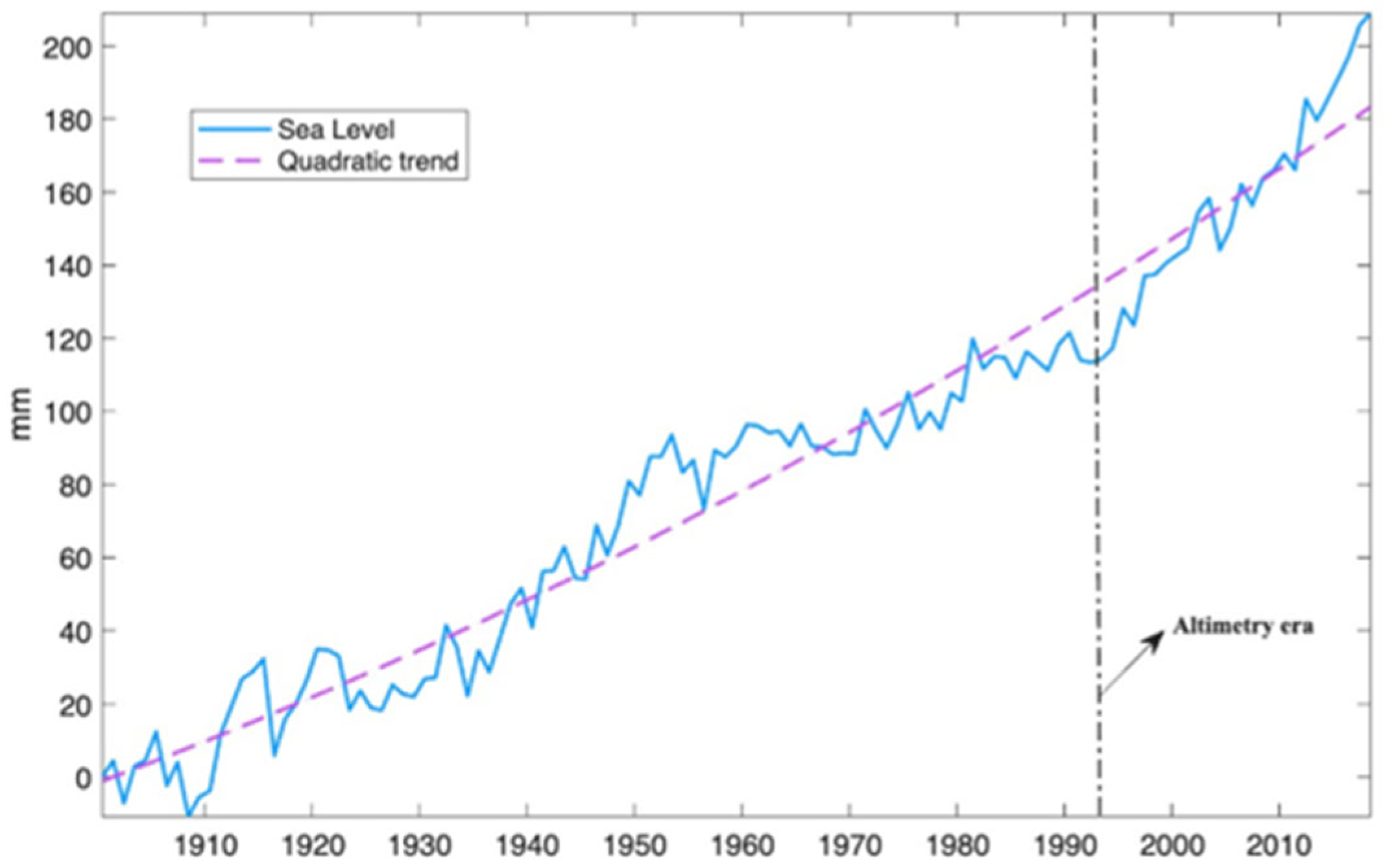
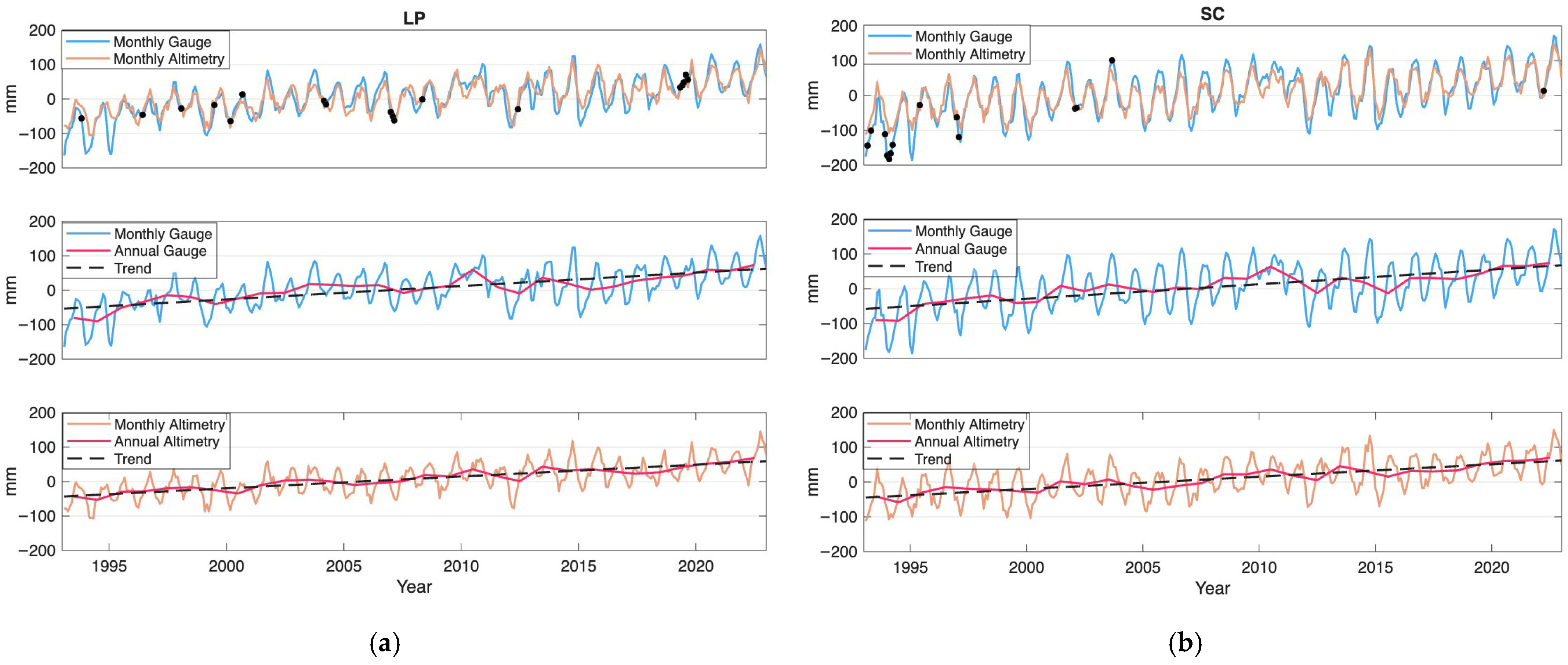
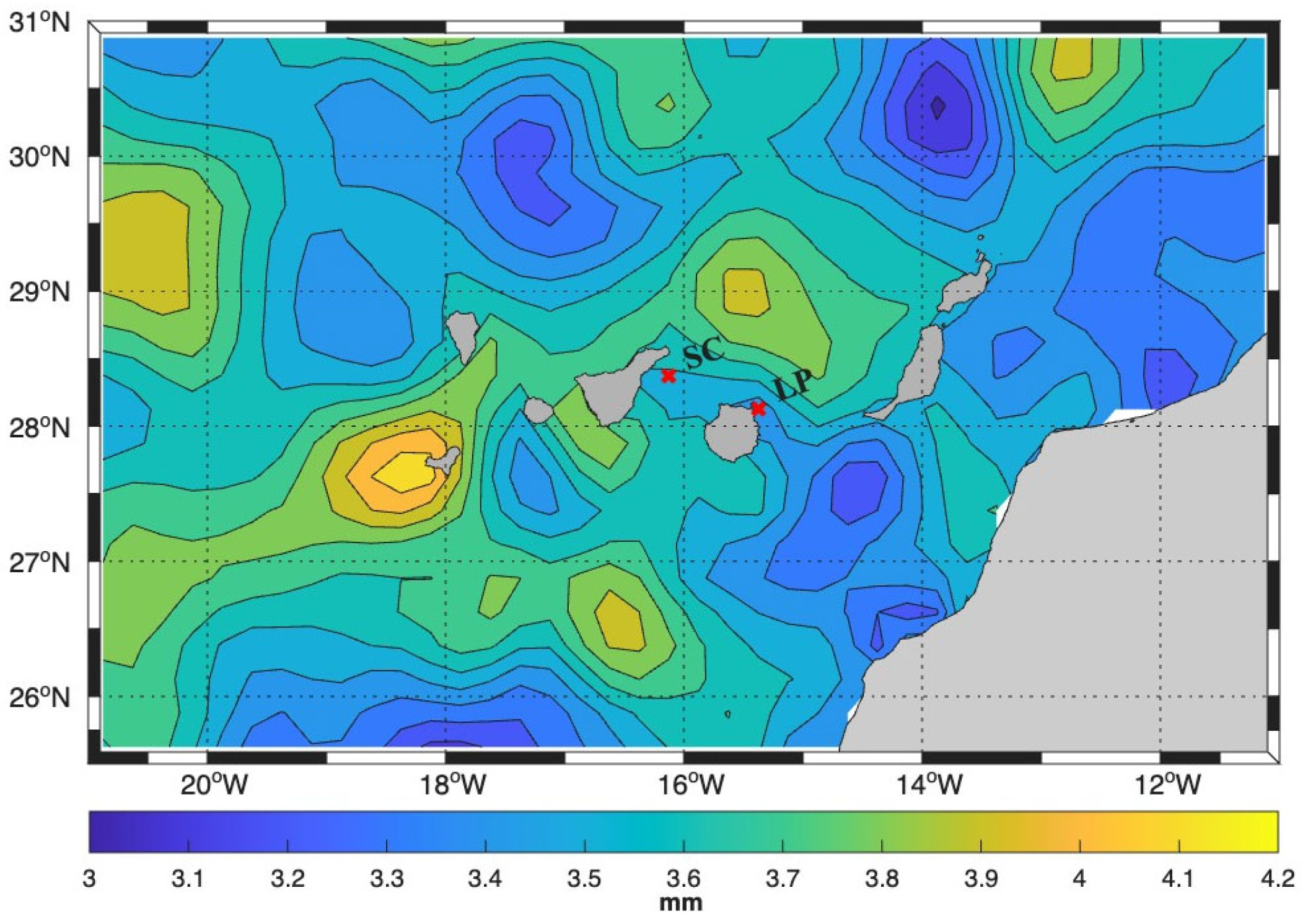
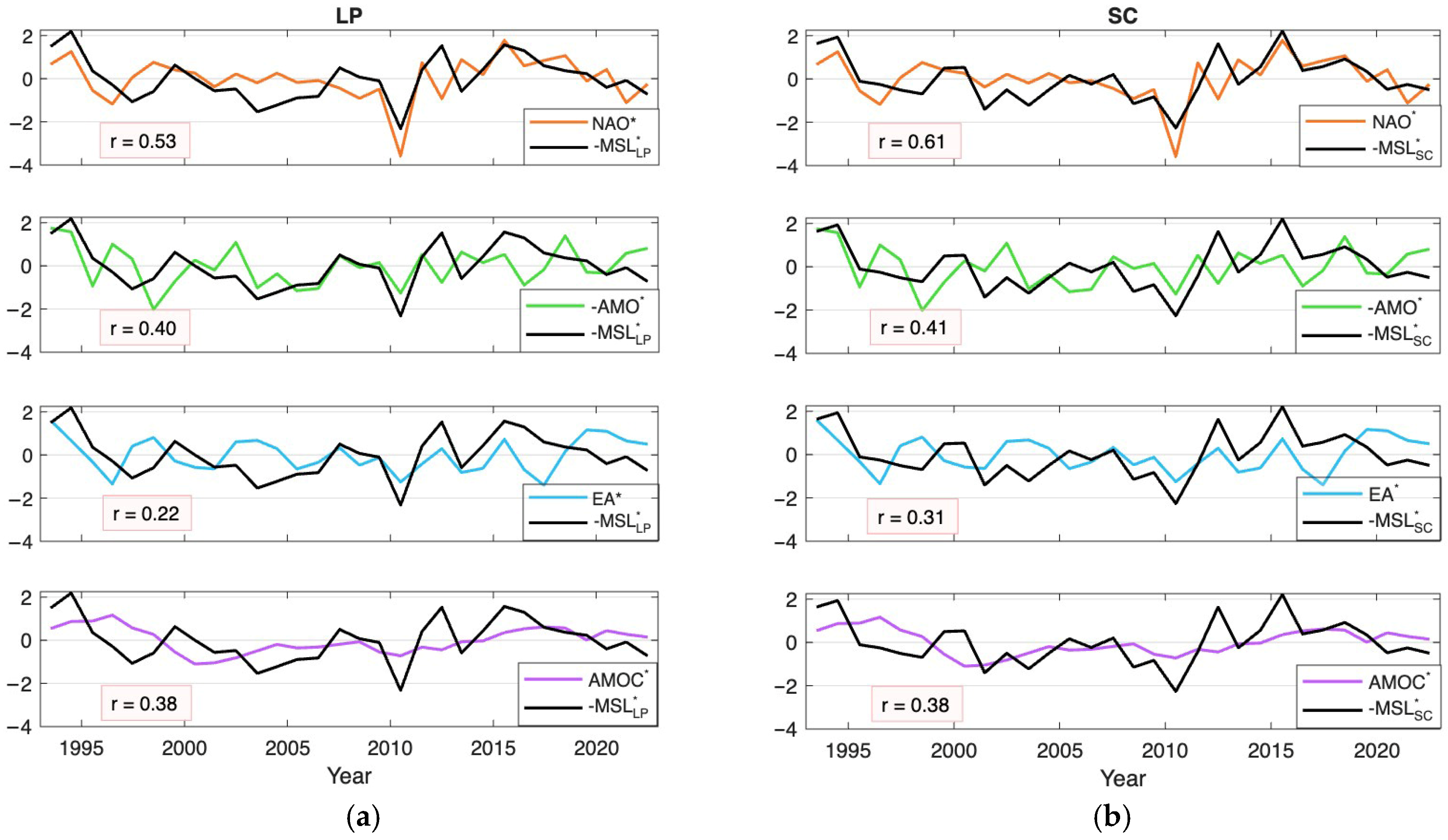
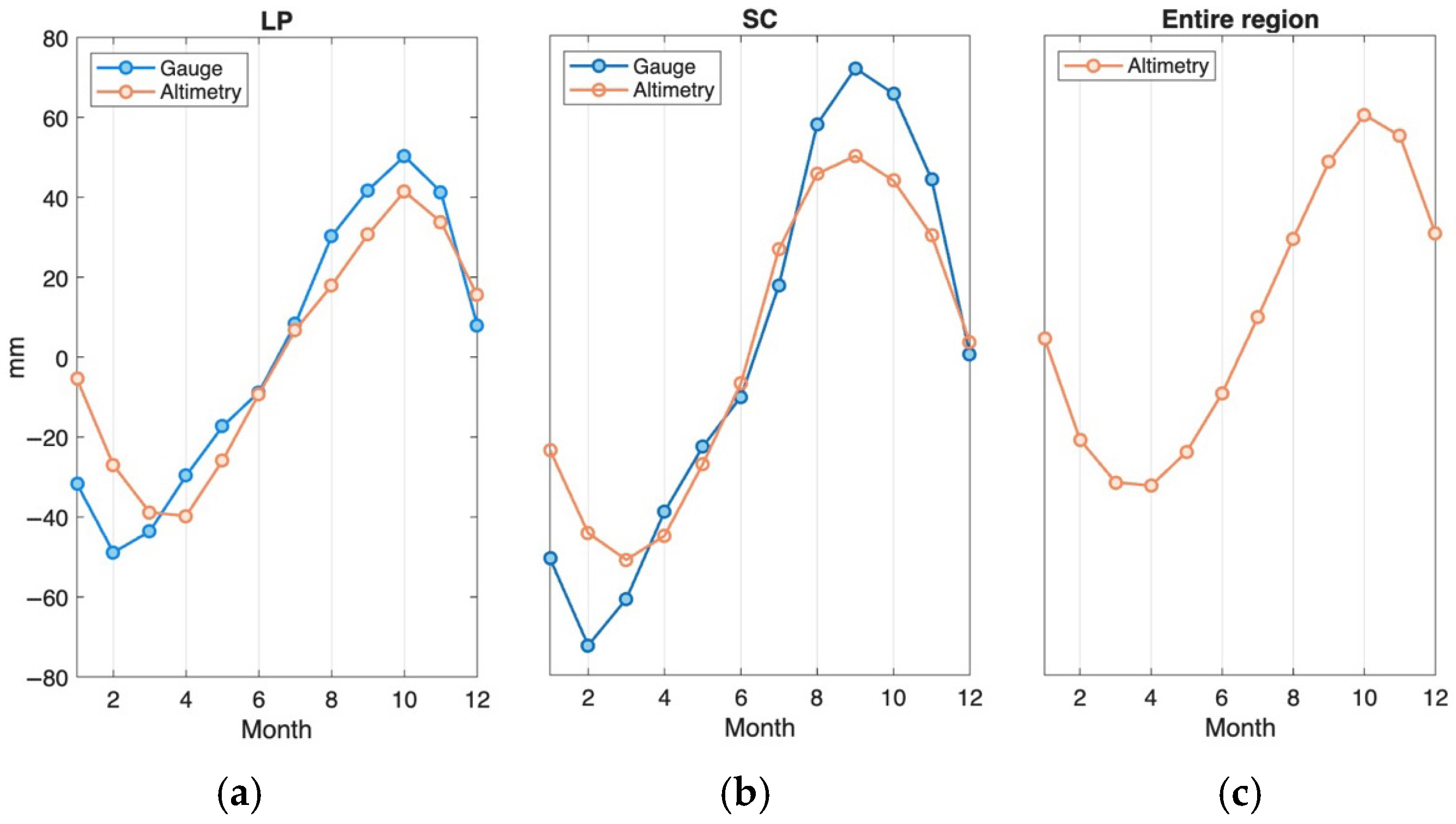
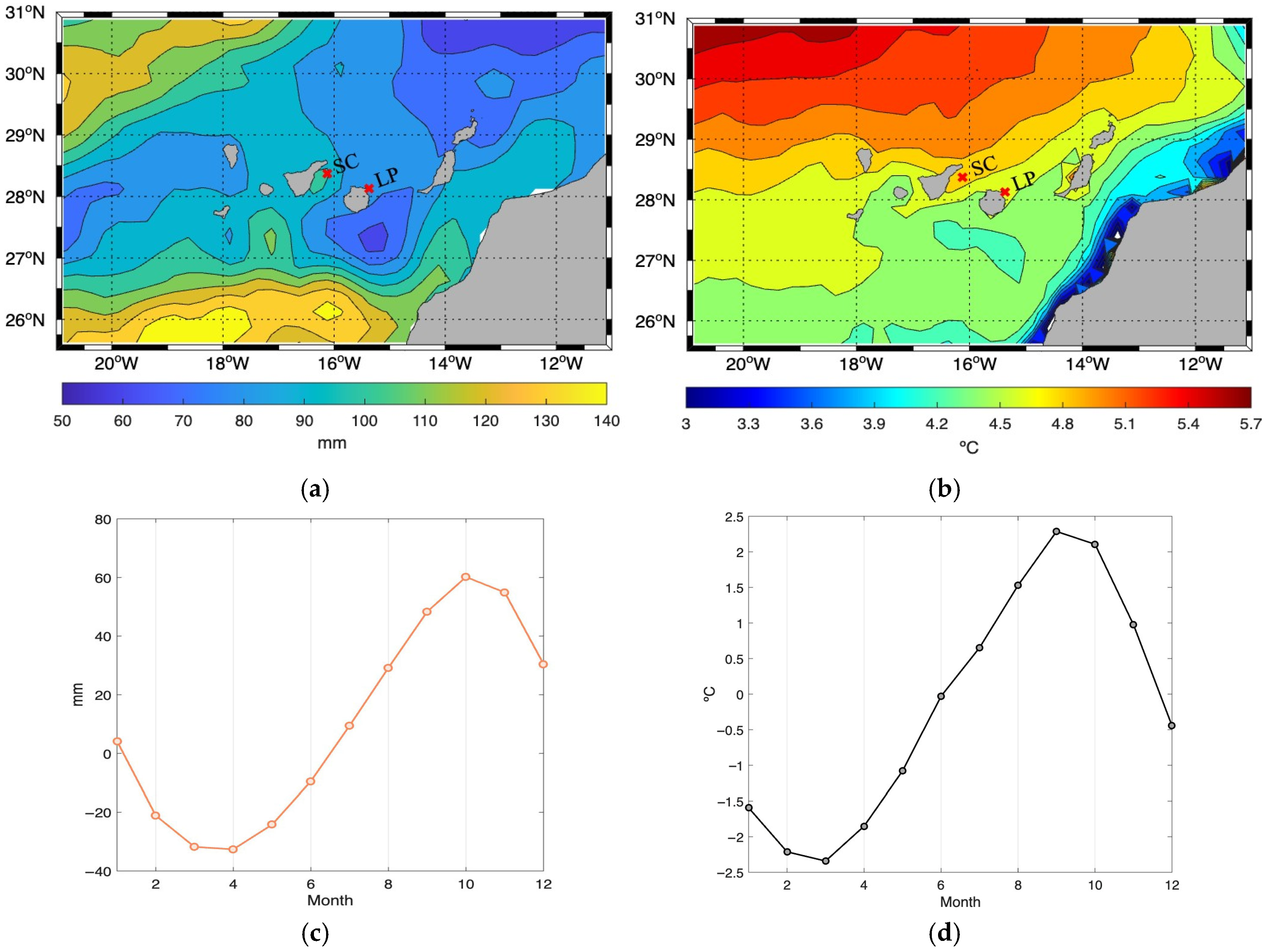

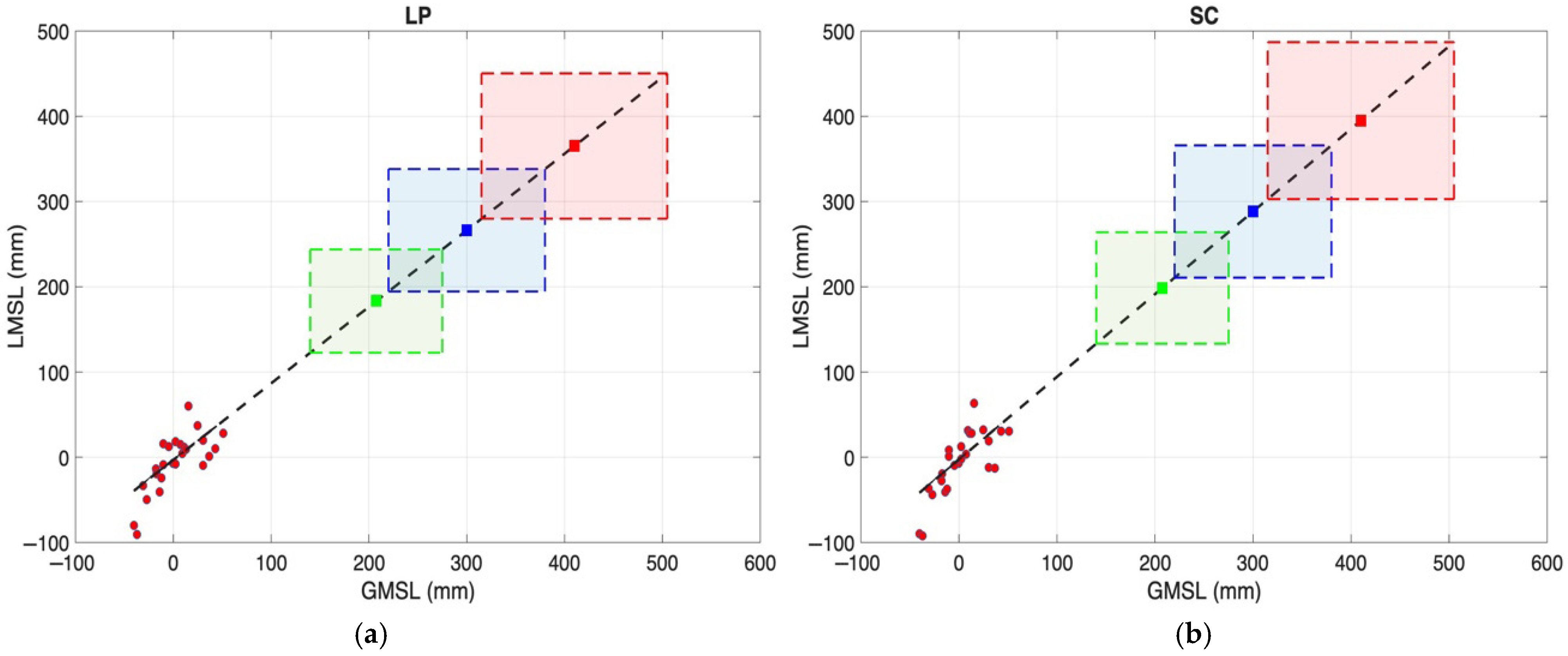
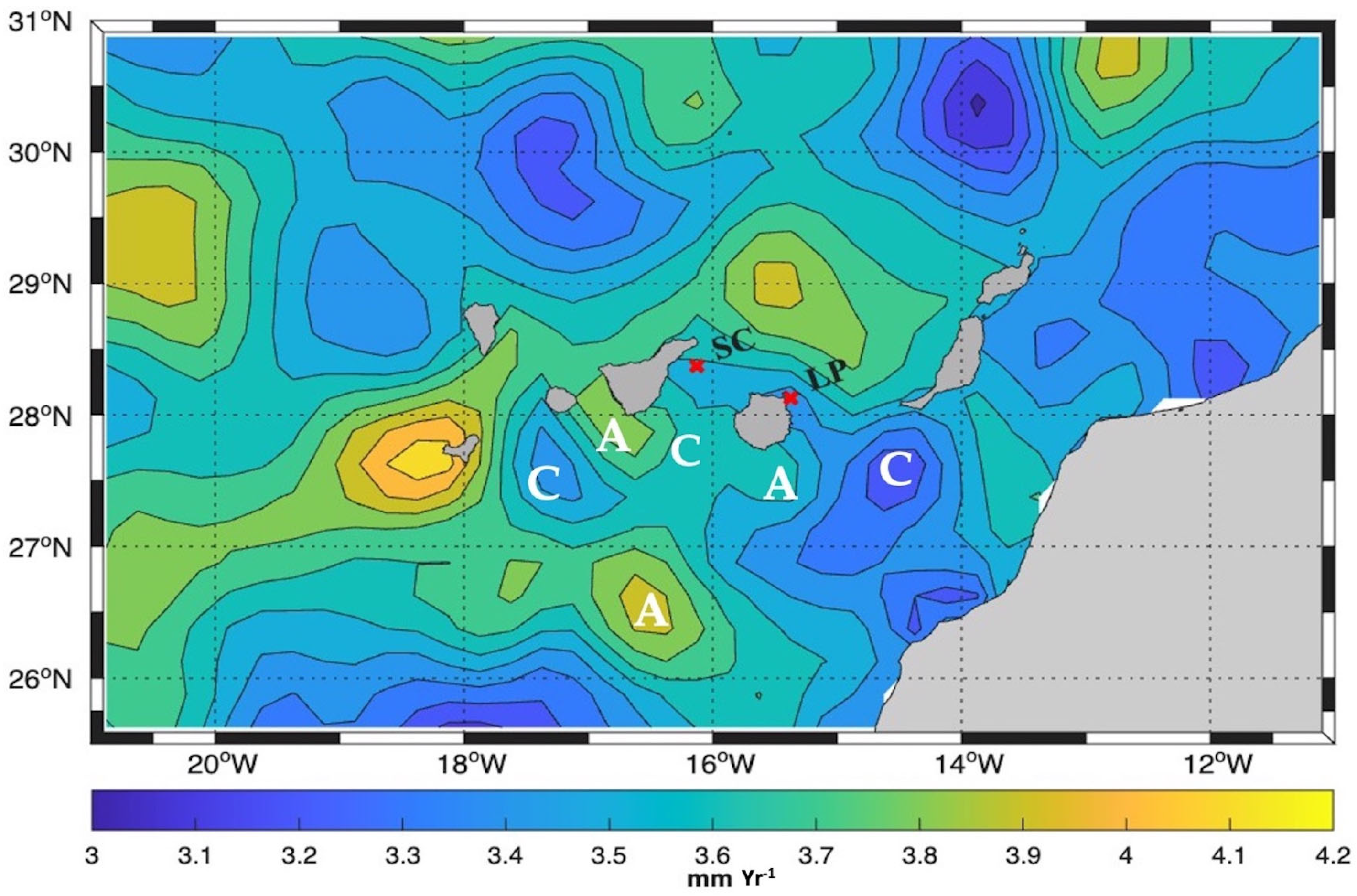
| LP | SC | |
|---|---|---|
| Tide gauge trend | 4.04 ± 0.83 (0.83) | 4.38 ± 0.93 (0.85) |
| Altimetry trend | 3.38 ± 0.41 (0.62) | 3.52 ± 0.45 (0.59) |
| Difference | 0.51 ± 0.55 (0.66) | 0.69 ± 0.55 (0.41) |
| LP | SC | |
|---|---|---|
| SSP1–1.9 | 182.78 ± 60.47 | 202.40 ± 66.67 |
| SSP2–4.5 | 265.63 ± 71.67 | 293.76 ± 79.01 |
| SSP5–8.5 | 364.18 ± 85.11 | 402.40 ± 93.83 |
| LP | SC | PERIOD | |
|---|---|---|---|
| PFEFFER & ALLEMAND [22] | −1.92 ± 0.48 | −2.48 ± 0.33 | 1992–2013 |
| BARBERO ET AL. [34] | −1.68 ± 0.81 | −2.40 ± 0.39 | 2000–2015 (LP) 2008–2015 (SC) |
| GNSS (SONEL) | Not robust | −1.55 ± 0.20 | 2007–2014 |
| PSMSL | Not robust | −0.59 ± 0.3 | 2007–2023 |
| PRESENT STUDY | −0.51 ± 0.55 | −0.69 ± 0.55 | 1993–2022 |
| SCENARIO | NASA PROJECTION FOR 2050 (LP AND SC) | LP | SC |
|---|---|---|---|
| SSP1–1.9 | 260 (170–360) | 183.22 ± 60.62 | 198.60 ± 65.45 |
| SSP2–4.5 | 280 (190–380) | 266.29 ± 71.85 | 288.29 ± 77.57 |
| SSP5–8.5 | 310 (220–400) | 365.08 ± 85.32 | 394.94 ± 92.11 |
Disclaimer/Publisher’s Note: The statements, opinions and data contained in all publications are solely those of the individual author(s) and contributor(s) and not of MDPI and/or the editor(s). MDPI and/or the editor(s) disclaim responsibility for any injury to people or property resulting from any ideas, methods, instructions or products referred to in the content. |
© 2025 by the authors. Licensee MDPI, Basel, Switzerland. This article is an open access article distributed under the terms and conditions of the Creative Commons Attribution (CC BY) license (https://creativecommons.org/licenses/by/4.0/).
Share and Cite
Ibeas, M.; Martínez-Marrero, A. Long-Term Trends, Interannual Variability and Seasonal Patterns of Mean Sea Level in the Canary Islands. J. Mar. Sci. Eng. 2025, 13, 2193. https://doi.org/10.3390/jmse13112193
Ibeas M, Martínez-Marrero A. Long-Term Trends, Interannual Variability and Seasonal Patterns of Mean Sea Level in the Canary Islands. Journal of Marine Science and Engineering. 2025; 13(11):2193. https://doi.org/10.3390/jmse13112193
Chicago/Turabian StyleIbeas, Mikel, and Antonio Martínez-Marrero. 2025. "Long-Term Trends, Interannual Variability and Seasonal Patterns of Mean Sea Level in the Canary Islands" Journal of Marine Science and Engineering 13, no. 11: 2193. https://doi.org/10.3390/jmse13112193
APA StyleIbeas, M., & Martínez-Marrero, A. (2025). Long-Term Trends, Interannual Variability and Seasonal Patterns of Mean Sea Level in the Canary Islands. Journal of Marine Science and Engineering, 13(11), 2193. https://doi.org/10.3390/jmse13112193







